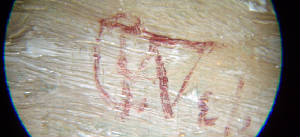|
Monet Man Fishing |
|
|
Academic Research
CHARLES T. WEBBER (1825-1911) Exhibited: Gallery on Charles T. Webber is known for his portrait,
historical, narrative and figure work. The artist's style was realism and not impressionism. West Fourth Street was the artist
district in Closson's Art Galleries were located on West Fourth Street and Webber’s
Artistic Photographic and Picture Gallery was located near Closson’s Webber was presented at the Paris Salon,
in 1881 with his picture Long Shore Folk on the Bayou Teche. In 1886 Webber returned to During the years of Webber’s travels
to C. T. Webber, signed the study
in the lower left. The handwriting of CTWebber was confirmed with the signature photograph published in the exhibition
catalogue, The Golden Age; Cincinnati Painters of the Nineteenth Century, (Ohio Arts Council) 1979,
In 1905 the artist was 80 years of age
in poor health and in financial difficulty. The Cincinnati Historical Society
Bulletin, Vol. 37, Summer 1979, No. 2, (Eden Park, Cincinnati, Ohio, 1979), p. 142.
Biographical
Notes: CHARLES
T. WEBBER (1825-1911) Mary Syre Haverstock, Artists in Ohio
1787-1900, A Biographical Dictionary, p.916-917 (Kent State UP, 2000) Artist, biography of Charles T. Webber. The Cincinnati Historical Society
Bulletin, Vol. 37, Summer 1979, No. 2, (Eden Park, Cincinnati, Ohio, 1979), p. 142. J. Rettig, The letter states the purchase of
the painting is to assist the artist, Webber in paying his debts. The painting purchased was the Underground Railroad.
Another unfinished composition by the same name, but undated is in the collection of The Cincinnati Historical Society. Ibid, p.143. C. T. Webber and Frank Duveneck
were friends (both from Robert C. Vitz, The Queen of the Arts,
(Kent State University Press, 1989), p.160. Webber, arrived from Ibid p. 234. Ibid p. 234. In 1897 Ibid. p 244. The regional Artist Biographical Research Researched & written by: Janet G. Smith, ISA International Society of Appraisers
Established: 1866 Owner: A. B. Closson Location:
Times Star, April 11, 1956 Closson Art Galleries was originally Closson-Traxel
and Moss. The Closson’s The 1907 Poor health forces A. B. Closson
to leave The 1911 Closson’s Dealer Biographical Research Researched & written by: Janet G. Smith, ISA Member of the International Society of
Appraisers
Patricia Mainardi, The End of the Salon:
Art and the State in the Early Third Republic (Cambridge: Cambridge UP, 1993) p.14. The salon decided to allow artists to produce
small easel pictures. The Salon sold the small pictures directly to private collectors. Harrison White and Cynthia White, Canvases
and Careers: Institutional Change in the French Painting World (New York: John Wiley & Sons, 1965) p.79. The
John House, Monet Nature into Art,
(Yale UP, New Haven and London, 1986) p. 8. "He lost a close friend on Manet's
death in 1883 and was the only Impressionist to be a pallbearer at his funeral. Thereafter, it was Renoir who, until his death,
remained Monet's closest friend..." Ibid. p. 9.
"Renoir and Monet visit Cezanne in the South of France in 1883." Ibid.
p. 11. "1897 George Petit purchased a small group of paintings. Petit probably contributed to Monet’s decision
to submit in 1880 to the Paris Salon urging him not to continue to sell at low prices. Monet wrote de Bellio (8 January 1880-
W letter 170 also letter to Duret, 8 March 1880 W letter 173) advising him the inexpensive paintings had come to an end. Durand-Ruel never had a contract with Monet who felt free to deal on his own." Ibid. p 26. "Pere Poly, Only the sea made
Monsieur Monet happy. He needed water, great quantities of it, and the more there was of it, even if it was spattering our
faces with foam, the better pleased he was." Le Braz, A. Illes Bretonnes (Paris, Belle-Ille-Sein, 1935)
p.49 Ibid. p. 148. "In the 1880s Monet normally
dated his paintings with the year in which he had began them, though signature and date were added on the picture's
completion for sale or exhibition, which was sometimes considerably later." Ibid. p.159. "His (Monet's) use of esquisse
and pochade is regularly different from the meaning he gave to etude. Esquisse regularly characterises
canvases on which he had finished work, but which were left in a sketchy state, not as highly finished as the paintings he
normally sold; a pochade refers to a rapid esquisse." Ibid. p. 159. “Sometimes I sell certain
esquisses a little more cheaply, but only to friends and artists.” In his 1891 letter shows, he continued on
occasion to see or given such esquisses to artist or friends. (30 June 1891, W letter 1116)" Definitions: Esquisse,
pochade and etude: Esquisse=the first sketch of a picture, Pochade=a quick sketch in colour, usually oils, made in the open
air, often used by landscape painters as a preliminary stage in the planning of a full-size picture, Etude=a simple study. James A. Ganz and Richard Kendall, The
Unknown Monet, This study information is important: during the year 1883 Monet was studying water, fishermen, etc. Anne Distel, Impressionism: The First
Collectors, trans. Barbara Perround-Benson (New York: Harry N. Abrams, 1990) p. 36. “George Petit’s archives
lost.” John House, Monet: Nature into Art,
(New Haven and London: Yale UP, 1986) pp.5-6. and Charles Stuckey, “Love Money and
Monet’s Debacle Paintings of 1880”, Monet at Vetheuil: The Turning Point, Exh. Cat. (Ann Arbor: University
of Michigan, 1998) pp. 41-62. Camille died September 1879, Alice Hoschede
provided care for the combined families' eight children. The family moved in 1883 to Giverny, overlooking water meadows
of the
Notes and comparisons
researched, compiled & written by: Janet G. Smith January 2007 Contact: kshfineart@yahoo.com
|
|
|
